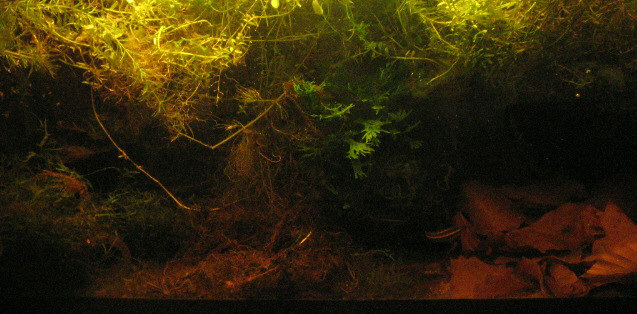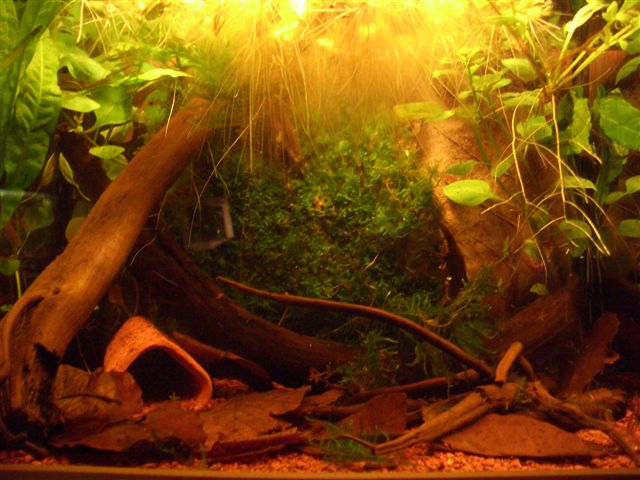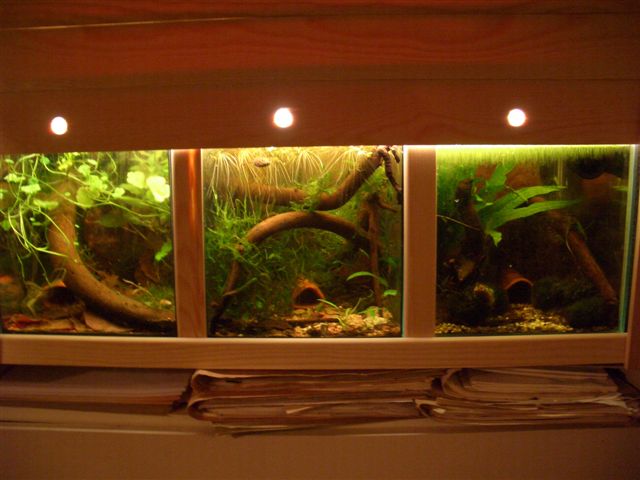Not every aquarium is suitable for licorice gouramis

A suitable aquarium for licorice gouramis is small, since the fish tend to “disappear” in larger tanks and it can become difficult to provide them with enough food. Their specific requirements with regards their environment can hardly be met in a normal community tank. They need tranquillity and are worried by lively fish swimming around them continously. Above all, they need extremely soft water with very low pH value (mostly between 4.5 and 6.5) so that many demanding plants will not grow well under these conditions. And they do not like bright lights. If normal liquid plant fertiliser is used, the concentration of dissolved substances in the water will be increased, but exactly the opposite is wanted. One have to realise that also in our bylack peat waters only poor plant grow is possible, due to the low content of nutrients.
It is still possible to have good licorice gourami tanks with plenty of plants; sometimes they can even be luxuriantly planted. But only few plants will survive and hence are suitable, despite the lack of light and nutrients in such water values: many mosses, e.g. Java moss, Cryptocorynes and especially Ceratopteris thalictroides, kept as a floating plant. This plant is very valuable, because it removes all excess nutrients from the water with their dense free floating roots. This is particularly advantageous for small tanks , because overfeeding, which happens often, can partly be compensated for.

Allan Brown has kept and bred his licorice gouramis in pairs very successfully in 5 L tanks. Of course he had to change the water regularly, often even daily. But already from a tank size of 10L upwards (tank size Peter Finke) this effort can be reduced to weekly partial water changes, if there is a good Ceratopteris growth. The ideal tank size for 1 pair of licorice gouramis is 20 to 25 L (Günter Kopic, Martin Hallmann and many others). It does not seem as if the fish would need more space. The keeping of licorice gouramis in pairs is advisable for those who intend to carry out extensive breeding. If several pairs are kept together, they should either be from the same species or significantly different – especially because of the similarity of the females. However under these conditions,
fry will only be brought up besides the older fish in very rare cases.

For each pair, a small cave is needed for the tank. The horizontal ceiling should not be inclined in a way that the egg clutches might slip out of it. The place within the tank and the material of the case plays no significant role. Even floating black film-boxes and sometimes cork bark will be accepted. are Small branches of soaked acidic wood from moors are advisable, which structure the waterspace as well as well soaked beech or oak leaves on the floor as shelter for small fry. This can be found in the natural habitats as well. But even in unplanted tanks without a substrate or any other decoration, just with a small filter and one or two caves, licorice gouramis can be bred.
Air-operated, weak sponge filters are better suited than fast centrifugal filters. Anyone who does not overfeed, can completely do without any filter. If you want to be on the safe side,you should use small filters and beginners should use them in any case. The water temperature can be as low as 23° C. In many cases (just as in the natural habitats), higher temperatures around 26 – 28°C can help to trigger the spawning behaviour. However, Parosphromenus cannot cope with higher temperatures for a long time. At around 30°C,they show clear signs of discomfort by using their labyrinth hectically (what they usually not do, except for building the bubble nests), this indicates any improper water value, often too high temperature.
(PF)

